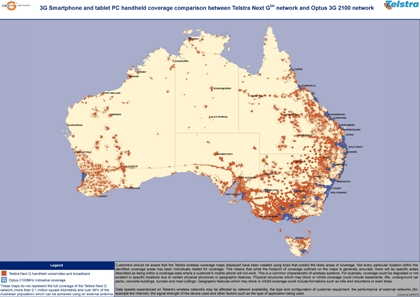Telstra brags, but Optus catching up


Telstra has taken a swipe at Optus by publishing a set of maps showing the national mobile coverage of both carriers, accompanied by statements putting down its competitor's network.

One of Telstra's coverage comparison maps(Credit: Telstra)
"Telstra's competitors are still trying to catch up with Next G," Telstra spokesperson Rod Bruem said in a blog post linking to the new coverage maps, saying that when "going out bush" it paid to check the extent of a network.
His blog post and the Telstra site sporting the coverage maps both claim that the difference is due to Optus using two different frequencies for its network — 900MHz and 2100MHz.
"The problem is that some very popular devices, such as the iPad and the iPhone, are not compatible with the 900MHz spectrum that Optus uses for 3G coverage outside major metropolitan areas," Bruem said.
"The result is that the devices might still work, but at limited data speeds. So accessing mobile internet or email is a significantly slower experience and some of the cool apps won't even work at all."
The new iPhone 4 will, however, have support for the 900MHz spectrum.
Bruem finished with words echoing those of the company's CEO at the end of last month.
"Telstra never claims to have the cheapest prices, but as they often say in the bush, you get what you pay for," Bruem said.
However, analyst house IDC today claimed Optus' 3G mobile broadband offering was only 4 per cent behind Telstra's Next G offering across a range of criteria — despite acknowledging Telstra's network was on average 60 per cent faster.
The group conducted 2000 independent tests over a nine-month period to produce a comprehensive report on mobile broadband performance in Australia. The full report costs $3500.
"IDC's research showed that Telstra scored more highly than its competitors, with average download speeds nearly 60 per cent faster than its nearest rival and no network fallback to 2G encountered. The user experience on Telstra was often similar to a good quality residential fixed broadband connection," the group's telecommunications market analyst Mark Novosel said in a statement.
"Optus' performance soared in 2009, scoring similarly to Telstra, although slightly more network fallback was experienced. However, performance was fairly consistent and well above both of VHA's networks," he added.
The analyst stated that Optus' 3G network now provided a viable alternative to Next G, for anyone willing to sacrifice some coverage and speed in favour of cost savings. "Optus was only four percent behind, after demonstrating a strong improvement in performance across all metrics assessed, having improved 20 per cent from 2008," he said.
In general, Novosel said average speeds across the entire mobile broadband ecosystem had improved by 68 per cent since 2008 — reaching 2.94Mbps. Upload speeds also surged — the average upload speed measured in 2008 was 1.24Mbps — compared with 460Kbps in 2008.
ZDNet Australia has contacted Optus for comment. The carrier had not yet responded at the time of writing.